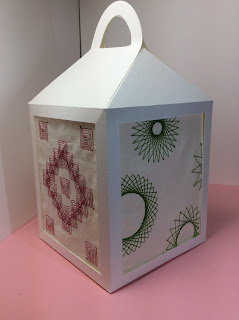A Slice Form Flower Vase With Valentine Roses
(I have included all of the cut files. No coding is necessary. I would like the users of my blog to be inspired by the Turtlestitch coding.)
The paper roses are spirals that are rolled with tweezers and then glued to a base. The roses and vase are about seven inch tall.
Here is the PDF. I used 65 lb. cardstock.
Here is the .Studio file.
Here is the SVG.
The roses in this design were coded in TurtleStitch which is based on the SNAP! programming language. TurtleStitch is a program which can generate code for an embroidery machine. It can also create these same designs as a line drawing for the Silhouette. Here is my code on the TurtleStitch website. https://www.turtlestitch.org/run#cloud:Username=Elaine&ProjectName=Rolled%20Paper%20Flowers%20w%2fLeaves
Transferring the TurtleStitch designs to the Silhouette Software
Export the file from TurtleStitch as an SVG and open it in the Silhouette Studio program. "Ungroup" the images under the "Object" menu.
"Offset" each image separately. The "Offset" was .05 inches for the circular spiral.
"Ungroup" the image from the "Object" menu.
Pulling the images apart resulted in the above images. The image on the left of this photo is the rolled flower piece. The other two images are not needed and can be deleted. Resize the circular spiral to your personal preference.
For the triangular spiral and the leaves, the Silhouette software seems to have too many points for these designs and the images gets distorted when it is "Offset". To rectify this problem, "Simplify" the image in "Point Editing" mode and then "Offset" the image. The triangular spiral is offset at .1 inches and the leaves by .09 inches.
Making the Valentine Roses and Vase
Use tweezers to roll the rose.
Start at the widest end and roll inward.
Remove the tweezer. The rose will unroll slightly but this is ok.
Here are three roses that have been rolled and then released from the tweezers (not glued yet). The two roses on the left are the circular spiral and the one on the right is the triangular spiral. I made three sizes of the sepal (green flower base) so that you can accommodate any size rose depending on how tightly the rose was wound.
Apply glue to the circular base. Notice that I used a lot of glue. You can use a hot glue gun instead of glue. If you use regular glue, you will have to wait for the glue to dry.
Glue on the correct size sepal which is the starlike part underneath the flower. Repeat for all of the roses. It is nice to make a variety of flower sizes for interest in your flower arrangement.
Score the center of each leaf to add a three dimensional effect to the leaves. Glue on the leaves to the slice form vase piece. There are two sizes of leaves for variety.
Two slice form vase pieces are glued together to provide a sturdier structure. Apply glue to the slice form vase piece with the leaves. Do not glue the top half of the buds as this piece needs to be splayed apart.
Splay apart the buds. Glue on the heart embellishment on top of the heart design on either side of this slice.
Apply glue to the bud.
Attach the rose. Repeat for the other rose.
The rose slice is then slid into the circle pieces. Repeat for all of the other rose slices.
The roses are a beautiful gift for Valentine's Day.









































